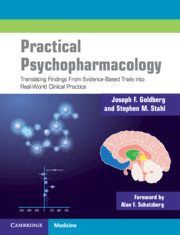 Practical Psychopharmacology
Practical Psychopharmacology from Part I - General Principles
Published online by Cambridge University Press: 19 October 2021
Previous chapters have described ways in which “real-world” patients usually present with a diversity of psychiatric, medical, psychosocial, and other features that make a “one-size-fits-all” approach to treatment problematic. Large-scale randomized trials typically favor diagnostic uniformity so that all enrolled subjects more or less display the same kinds of symptoms under study. Consequently, the controlled trials literature that informs evidence-based practice largely comes from rarified, homogeneous study groups with rigidly defined diagnostic criteria. As a result, such studies trade off optimal outcomes (“efficacy”) for generalizability (“effectiveness”) under more ordinary conditions. This is why so-called “effectiveness” studies such as the Clinical Antipsychotics Treatment Intervention Effectiveness trial (CATIE; see Chapter 15) strive to enroll representative patients with comorbidities, imperfect treatment adherence, and issues with drug tolerability, adopting “bottom line” primary outcome measures such as “all-cause dropout.” No matter how well a treatment can work, the pragmatic concern remains how well it actually does work in real-life settings.
To save this book to your Kindle, first ensure [email protected] is added to your Approved Personal Document E-mail List under your Personal Document Settings on the Manage Your Content and Devices page of your Amazon account. Then enter the ‘name’ part of your Kindle email address below. Find out more about saving to your Kindle.
Note you can select to save to either the @free.kindle.com or @kindle.com variations. ‘@free.kindle.com’ emails are free but can only be saved to your device when it is connected to wi-fi. ‘@kindle.com’ emails can be delivered even when you are not connected to wi-fi, but note that service fees apply.
Find out more about the Kindle Personal Document Service.
To save content items to your account, please confirm that you agree to abide by our usage policies. If this is the first time you use this feature, you will be asked to authorise Cambridge Core to connect with your account. Find out more about saving content to Dropbox.
To save content items to your account, please confirm that you agree to abide by our usage policies. If this is the first time you use this feature, you will be asked to authorise Cambridge Core to connect with your account. Find out more about saving content to Google Drive.